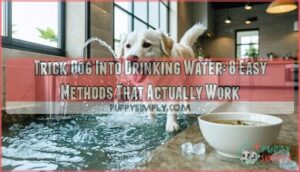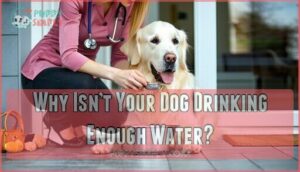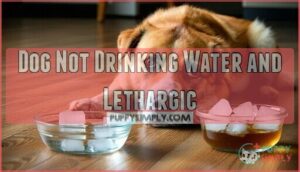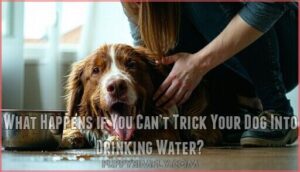This site is supported by our readers. We may earn a commission, at no cost to you, if you purchase through links.
 You can trick a dog into drinking water using simple strategies that work like magic. Add low-sodium chicken broth to their bowl for irresistible flavor. Switch to a water fountain since many dogs prefer moving water over stagnant bowls.
You can trick a dog into drinking water using simple strategies that work like magic. Add low-sodium chicken broth to their bowl for irresistible flavor. Switch to a water fountain since many dogs prefer moving water over stagnant bowls.
Place multiple water stations around your home so they can’t avoid hydration. Mix wet food with extra water to sneak in fluid intake. Clean their bowl daily because dogs won’t drink from dirty containers.
Try ice cubes as treats on hot days. Move their water away from food if they’re picky eaters. These methods address common reasons dogs avoid drinking and guarantee proper hydration for peak health.
Table Of Contents
- Key Takeaways
- How Much Drinking Water Does Your Dog Need Daily?
- Why Isn’t Your Dog Drinking Enough Water?
- Don’t Wait, Hydrate!
- My Dog Won’t Drink Water but Eats
- How to Get a Sick Dog to Drink Water
- Dog Not Drinking Water and Lethargic
- What Happens if You Can’t Trick Your Dog Into Drinking Water?
- Can I Flavor My Dog’s Water?
- Frequently Asked Questions (FAQs)
- How to trick a dog into drinking more water?
- How to hydrate a dog when they won’t drink?
- How do you make a dog drink water when he doesn’t want to?
- How do you entice a sick dog to drink water?
- How can I monitor my dog’s water intake?
- Is there a way to make drinking water more interesting for my dog?
- What are the benefits of giving my dog filtered water?
- Is there a difference between tap water and bottled water for my dog?
- Is ice water safe for dogs?
- Can dogs drink distilled or filtered water?
- Conclusion
Key Takeaways
- You can add low-sodium chicken broth to their water bowl or freeze it into ice cubes to make drinking irresistible through natural flavoring that appeals to their taste preferences.
- You’ll boost hydration by switching to a pet water fountain since dogs naturally prefer moving water over stagnant bowls, and the continuous flow triggers their instinct to drink.
- You should place multiple water stations throughout your home and mix extra water into wet food to sneak in fluid intake without your dog realizing they’re getting more hydration.
- You need to monitor daily water intake closely (one ounce per pound of body weight) and contact your vet immediately if your dog won’t drink for more than 24 hours, as dehydration becomes dangerous quickly.
How Much Drinking Water Does Your Dog Need Daily?
Your dog’s daily water needs aren’t rocket science, but they’re essential for preventing pet dehydration.
Your pup’s hydration isn’t complicated—but skipping it can spell serious trouble for their health.
Most dogs require about one ounce of water per pound of body weight daily.
That means your 50-pound Golden Retriever needs roughly 6-7 cups of water each day.
Active pups, nursing mothers, and dogs in hot weather need more canine fluids.
Monitor your dog’s water intake closely—proper dog hydration keeps kidneys functioning and prevents serious health issues.
Understanding these dog hydration needs helps you spot problems early.
Ensuring adequate daily water intake is vital for maintaining your dog’s overall health and well-being.
Why Isn’t Your Dog Drinking Enough Water?
Your dog’s water intake can drop for several reasons, from simple changes in routine to serious health issues that need attention.
Understanding these causes helps you identify whether your pup needs encouragement, environmental adjustments, or a trip to the vet to address serious health issues.
Lack of Physical Activity
Your couch potato pup might be skipping water breaks because they’re living a sedentary lifestyle. When dogs don’t get enough physical stimulation, their bodies don’t signal the same thirst response that active dogs experience.
It’s like expecting to feel parched after binge-watching Netflix all day—your body just doesn’t demand hydration the same way.
Here’s how to boost your dog’s exercise needs and naturally encourage dog drinking:
- Schedule 30-60 minutes of daily playtime importance activities like fetch or walks
- Create indoor obstacle courses during bad weather to prevent dog fatigue
- Use puzzle toys that require physical movement and mental engagement
- Incorporate swimming sessions, which naturally increase water consumption
- Plan regular hiking adventures to break the monotonous routine
Regular physical stimulation triggers natural thirst mechanisms, making dog hydration tips more effective. Active dogs instinctively seek water after exertion, turning dog dehydration prevention into an automatic behavior rather than a daily struggle to trick dog drinking water. Investing in proper dog exercise equipment can help create engaging physical activities for your dog, promoting a healthy lifestyle and ensuring your dog stays well-hydrated.
Change of Location
Your furry friend might be giving their water bowl the cold shoulder simply because of where you’ve placed it. Visible Placement matters more than you’d think. Dogs prefer Water Station setups in high-traffic areas where they naturally spend time.
Try Bowl Rotation every few days to spark curiosity. Location Variety keeps things interesting – place bowls near their favorite napping spots, by the back door, and in the kitchen.
Environmental Change from relocation or travel can make dogs hesitant about unfamiliar water sources.
| Location Strategy | Benefits |
|---|---|
| Multiple bowls throughout house | Increases accessibility by 30% |
| High-traffic areas (kitchen, living room) | Natural drinking reminders |
| Near food and rest areas | Convenient hydration opportunities |
Your Dog is Getting Older
Age catches up with our four-legged companions, and senior dog care becomes vital as their hydration habits change.
Older pet needs shift substantially – they’re less active, forget to drink, or struggle reaching water bowls. Mature dog health depends on recognizing these aging hydration challenges early.
To address potential health issues, understanding the causes of dog excessive drinking is vital.
Here’s your game plan for elderly canine tips:
- Monitor dog dehydration symptoms like sticky gums, sunken eyes, or slow skin snapping back when pinched
- Increase dog water by switching to wet food, which provides 75-80% moisture content compared to dry kibble’s 10-12%
- Use dog hydration methods like adding low-sodium broth to meals or placing multiple water stations around your home
These tricks to get dogs to drink work especially well when your senior pup needs extra encouragement to maintain proper dog water intake.
Illness Can Keep Your Dog From Drinking Enough Water
When illness strikes, your dog’s water intake often plummets. Sick dogs frequently lose their appetite for both food and water, creating a dangerous cycle of dehydration that can worsen their condition.
Recognizing dehydration signs becomes critical during illness. Check your dog’s gums – they should feel moist, not sticky or dry. Gently pinch the skin between their shoulder blades; it should snap back immediately. Delayed skin tenting indicates dehydration.
| Dehydration Signs | Normal | Dehydrated |
|---|---|---|
| Gum moisture | Wet, slippery | Sticky, tacky |
| Skin elasticity | Snaps back instantly | Returns slowly |
| Energy level | Alert, responsive | Lethargic, weak |
| Eye appearance | Bright, clear | Sunken, dull |
Medical intervention may be necessary for severe canine dehydration, especially when combined with vomiting or diarrhea.
Try a Water Fountain
Unlike stagnant water in traditional bowls, water fountains create an irresistible appeal that can transform your picky drinker into a hydration enthusiast.
The continuous water flow mimics natural freshwater sources, triggering your dog’s instinct to drink. Pet fountains offer multiple fountain benefits beyond simple aesthetics—they filter impurities and maintain cooler temperatures that dogs naturally prefer.
Most water fountains feature bubbling or flowing mechanisms that make dog refreshment more engaging than static pet water bowls. The constant circulation prevents bacterial growth while encouraging better dog water intake through sensory stimulation.
Some dogs who ignore their regular dog water bowl will enthusiastically approach a pet fountain’s moving water.
Choose stainless steel options for easier cleaning and durability. Remember to replace filters regularly and maintain proper hygiene to maximize your dog hydration efforts and guarantee the best pet hydration results.
When selecting a fountain, consider the importance of proper dog water systems to keep your dog healthy and hydrated.
Don’t Wait, Hydrate!
Dehydration sneaks up faster than you’d think, making immediate action vital for your dog’s wellbeing.
Don’t wait for obvious signs like lethargy or dry gums. Start implementing dog hydration strategies now to maintain proper fluid balance.
Monitor your pup’s drinking habits daily and use proven dog water intake tips like flavored ice cubes or broth additions. These dog hydration techniques guarantee consistent water intake before problems develop.
Remember, prevention beats treatment every time in the context of canine health and maintaining healthy hydration levels.
My Dog Won’t Drink Water but Eats
You’re dealing with a puzzling situation – your dog’s chowing down but skipping the water bowl entirely.
This selective eating behavior often signals they’re getting moisture from food but need extra hydration encouragement.
Here’s your game plan:
- Add wet food to meals – boosts Pet Food Moisture content substantially
- Try chicken broth ice cubes – combines Water Flavor Tips with cooling treats
- Place multiple water stations – improves accessibility throughout your home
- Use ceramic or stainless steel bowls – many dogs prefer these materials
- Mix water directly into kibble – sneaky Fluid Intake Strategies that work
How to Get a Sick Dog to Drink Water
When your furry friend’s under the weather, sick dog hydration becomes your top priority.
Getting adequate dog water intake during illness requires gentle persistence and smart strategies. Ensuring proper sick dog care is vital for recovery.
Here are three proven rehydration methods that work:
- Offer small, frequent sips – Give water every 30 minutes rather than expecting large amounts at once
- Add low-sodium broth – Mix chicken broth into water to make it more appealing during recovery
- Use ice cubes as treats – Cold water often appeals to sick dogs and provides gradual hydration
Monitor intake closely and consult your vet if drinking doesn’t improve within 24 hours.
Dog Not Drinking Water and Lethargic
When your dog’s not drinking water and acting sluggish, you’re looking at serious dehydration signs that need immediate attention.
Lethargy causes in dogs often link directly to poor water intake and canine hydration issues.
A lethargic dog who won’t drink creates a dangerous cycle – less activity means less thirst, worsening the problem.
Try offering ice cubes, moving water bowls closer, or adding low-sodium broth to make dog drink water.
Monitor dog fluids carefully and contact your vet if dog hydration solutions don’t work within hours, as this can lead to serious dehydration signs and require immediate attention.
What Happens if You Can’t Trick Your Dog Into Drinking Water?
If your dog still won’t drink water after trying these methods, you’re facing a serious health emergency that requires immediate veterinary attention.
Dehydration can cause organ damage or failure within hours, so don’t wait to see if your stubborn pup will eventually give in.
How Long to Rehydrate a Dog?
Rehydration time varies depending on your dog’s dehydration severity. Mild cases typically resolve within hours, while severe dehydration may require veterinary intervention and hospitalization for proper fluid balance restoration.
Monitor your pup’s hydration levels closely during recovery.
Here’s what affects canine hydration methods:
- Severity matters – Acute dehydration signs need correction over 1-4 hours with close monitoring
- Go slow when unsure – Unknown duration cases should rehydrate gradually over 24 hours
- Small doses work – Offer 1-2 ounces every 2 hours for steady dog water intake improvement
How Long Can Dogs Go Without Drinking?
When your dog refuses water, time becomes critical for their survival.
Every hour without water brings your dog closer to dangerous dehydration—don’t gamble with their life.
Dogs can typically survive 48-72 hours without drinking, but dehydration signs appear within 24 hours.
After three days without proper water intake, organ damage becomes likely and potentially fatal.
Your pup’s fluid balance depends on consistent dog hydration practices – they need one ounce per pound daily.
Watch for canine survival warning signs like lethargy, dry gums, and sunken eyes.
Don’t wait; severe dog health risks develop quickly without adequate hydration.
Your pup’s health is dependent on you recognizing these signs and taking action to prevent dehydration.
Can I Flavor My Dog’s Water?
Your pup’s finicky drinking habits don’t have to leave you high and dry. Yes, you can safely add flavor enhancers to encourage hydration.
Low-sodium broth additives work wonders – mix one part chicken broth with two parts water. Ice cubes made from meat infusions create appealing flavored liquids that most dogs can’t resist.
Water temperature matters too; many dogs prefer cooler drinks. These dog hydration tricks using natural flavoring water methods beat artificial sweeteners every time.
Always provide plain water alongside these broth-based alternatives for ideal dog water preferences. Many owners rely on dog water additives to promote healthy hydration habits.
Frequently Asked Questions (FAQs)
How to trick a dog into drinking more water?
You can enhance your pup’s hydration by adding low-sodium chicken broth to their water bowl, freezing broth into ice cubes, or mixing water directly into their kibble for sneaky moisture.
How to hydrate a dog when they won’t drink?
Like coaxing a stubborn child, you’ll need creative tactics. Mix low-sodium broth into their food, offer flavored ice cubes, or switch to wet food containing 80% water to boost hydration sneakily.
How do you make a dog drink water when he doesn’t want to?
Mix low-sodium chicken broth into their water bowl, add ice cubes for temperature appeal, or soak their kibble in water.
You can also try moving water bowls to different locations around your home, which can be a complete solution to encourage drinking.
How do you entice a sick dog to drink water?
Offer warm, low-sodium chicken broth or bone broth to entice your sick pup.
Add ice cubes for temperature appeal.
Try hand-feeding small amounts using a syringe if necessary, ensuring gentle encouragement without forcing consumption, to provide a comfortable and gentle experience.
How can I monitor my dog’s water intake?
Watching your dog’s water intake is like being a detective tracking clues.
Measure daily amounts in their bowl, mark levels with tape, or use measuring cups.
Monitor bathroom breaks and check for dehydration signs regularly.
Is there a way to make drinking water more interesting for my dog?
Spice things up by adding low-sodium broth or a splash of unsalted tuna water to their bowl.
Toss in flavored ice cubes or try a pet water fountain—dogs love the sound of running water!
What are the benefits of giving my dog filtered water?
Filtered water removes chlorine, heavy metals, and bacteria that tap water contains.
You’ll protect your dog’s kidneys, improve taste, and reduce digestive upset.
It’s like upgrading from fast food to fine dining.
Is there a difference between tap water and bottled water for my dog?
Both tap and bottled water work fine for your dog.
Tap water’s usually cheaper and just as safe, while bottled water offers consistency when traveling.
Test different types to see what your pup prefers drinking, especially when considering consistency.
Is ice water safe for dogs?
Despite concerns about bloat, ice water is perfectly safe for dogs.
Cold water actually helps regulate their body temperature and many dogs prefer it at 59°F.
Add ice cubes as cool treats!
Can dogs drink distilled or filtered water?
Yes, dogs can safely drink both distilled and filtered water.
Many dogs actually prefer filtered water’s taste over tap water.
You can experiment with different water types to see what your pup enjoys most.
Conclusion
Like a compass guiding you through uncharted territory, these proven methods will lead you to hydration success with your canine companion.
You’ve learned how to trick dog into drinking water using flavoring, fountains, multiple stations, and strategic placement techniques.
Remember that consistent application of these strategies prevents dehydration-related health complications.
Monitor your dog’s water intake daily and consult your veterinarian if problems persist.
With patience and persistence, you’ll transform even the most stubborn water-avoider into a well-hydrated, healthy pet.
- https://link.springer.com/chapter/10.1007/978-1-4612-5692-2_7
- https://www.frontiersin.org/articles/10.3389/fvets.2020.00292/full?&utm_source=Email_to_authors_&utm_medium=Email&utm_content=T1_11.5e1_author&utm_campaign=Email_publication&field=&journalName=Frontiers_in_Veterinary_Science&id=515055
- https://europepmc.org/article/med/447577
- https://www.petmd.com/dog/nutrition/evr_dg_the_importance_of_water
- https://www.researchgate.net/publication/267573501_Water_-_Dogs_like_it_cold











